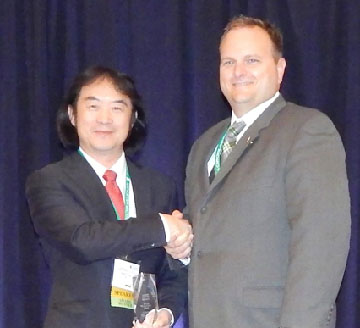What you Need to Know About the 3rd Amendment to the China Trademark Law
Jack Chang
Vice Chairman, Quality Brands Protection Committee
The two primary objectives of the 3rd Amendment to the China Trademark Law (TML), effective May 1, 2014, were to expedite the examination process and to strengthen trademark protection. After the National People’s Congress (NPC, the People’s Republic of China Parliament) publicized the draft amendment in December 2012, the Quality Brands Protection Committee (QBPC www.qbpc.org.cn) reviewed the draft with the China Association of Enterprises with Foreign Investment (CAEFI) and raised many concerns. CAEFI responded by setting a February 2013 meeting between the QBPC and the NPC Legal Affairs Department. The NPC subsequently invited QBPC to a May 2013 meeting to comment on the 2nd NPC draft amendment, which addressed several important concerns. Below I review in detail some of the specific positive changes that resulted from this process—and some of the remaining challenges.
POSITIVE CHANGES
Eliminating the gap between the renewal of trademark registration and the Customs recordal
Under the old TML, a trademark renewal application could only be filed within six month of expiration. However, it normally took more than six months to receive the trademark renewal certificate. As a result, by the time the renewal certificate was received, the Customs recordal had expired. Trademark owners, who needed the Chinese Customs’ border protection to help fight against cross-border trade of counterfeit goods, had no protection between the time of the expiration of the trademark registration and the completion of renewal application and Customs re-recordal. NPC addressed this problem by allowing trademark renewal applications twelve months before expiration (Para. 1, Art. 40 of the TML). This should eliminate the border protection gap.
Extending the deadline for filing administrative litigation against unfavorable decisions by the China Trademark Review & Adjudication Board (TRAB)
The NPC agreed to extend this deadline from fifteen to thirty days to allow for ample time to prepare the case. (Art.34, Para. 3 of Art. 35, Para. 3 & 4 of Art. 44, Para. 2 of Art. 45 and Art. 54).
Fixing Trade-Related Aspects of Intellectual Property Rights (TRIPs) compliance gap
Under the old TML, the implements of counterfeiting (computers, equipment and machinery, etc.) could only be seized if they were “exclusively” used to manufacture trademark infringing goods or labels. Article 46 of the TRIPs (in which China is a signatory) adopts the term “predominant use” rather than “exclusive use,” which makes a significant difference on law enforcement’s ability to seize the implements. The NPC agreed to adopt the term “predominant use” in the revised TML (Para. 2 of Art. 60).
REMAINING CHALLENGES
Unauthorized use of another’s registered trademark for export (commonly referred as “OEM for Export”) does not constitute trademark infringement
The NPC, following the recommendation of the judiciary, defines use of a trademark as “the conduct of differentiating the source of the goods” (Art. 48). This promotes the view that unauthorized use of another’s registered trademark in China on goods for an overseas market does not constitute trademark infringement. This is because the function of the trademark in “differentiating the source of the goods” was not fulfilled within China and the goods not distributed in China, making it unlikely that unauthorized trademark use would confuse Chinese consumers. Several civil courts have adopted this view in their decisions. This also makes it difficult to characterize trademark counterfeit as a crime. As a result, administrative enforcement agencies are discouraged from taking actions against unauthorized use of another’s registered trademark as long as the alleged “infringer” claims that the goods are for an overseas market. This problem, if not fixed quickly, may be devastating to brand owners (domestic or foreign). After QBPC raised this issue to the highest authorities and provided constructive solutions, some academic thought leaders and the judiciary have followed suit and are willing to work with industry, including the QBPC, on finding a workable solution.
Bad faith registration
Expediting the trademark examination process was a primary objective of the 3rd Amendment, which abolished the seemingly endless process of opposition, appeal, administrative litigation, and re-examination of the old TML. Under the new TML, a prior rights holder or an interested party has only one chance to oppose a possible bad faith application. Once the opposition action is dismissed by the China Trademark Office (CTMO), the preliminarily approved application will immediately become a registered trademark. The party opposing the registration may still file an invalidation action against the registered trademark but it cannot stop the registrant from using the trademark while the subsequent litigation—which may take two to three years to complete—is pending. This poses a serious threat to trademark owners who face bad faith application and registration issues in China. The change also generates a very large number of trademark-related administrative litigation cases for the Beijing Intellectual Property Court and the High Court. To make things more challenging, the CTMO and TRAB in general do not use Article 7 (Good Faith article) to revoke or invalidate bad faith applications or registrations, as Article 7 is not a legal basis for contesting these. Moreover, many foreign trademark owners, when trying to substantiate their opposition or invalidation actions, include evidence proving the long-term use of their trademarks outside China but CTMO, TRAB and Chinese courts accept such evidence only if owners prove prior use within China. Prior use in China must also have generated “a certain level of influence” before the filing date of the bad faith application/registration. Fortunately, the Beijing IP Court and High Court seem to have adopted a much more practical and reasonable view in their cases involving NUXE Laboratory (a French cosmetic company) and Facebook. In the NUXE case, the Beijing IP Court agreed many Chinese consumers are purchasing cosmetic products from overseas for personal consumption, and visiting the NUXE Laboratory’s official website for product information, making it obvious that the NUXE Laboratory’s trademark enjoyed good brand awareness among the Chinese consumers. In the Facebook case, both the Beijing IP Court and High Court expressed that a bad faith applicant/registrant violated the good faith article (Art. 7 and Para. 1 of Art. 44) by acquiring trademark registrations through deceptive or unfair approaches. Neither NUXE nor Facebook had physical operations in China. These rulings may result in more positive administrative litigation decisions from open-minded courts in Beijing against bad faith applications and registrations.
Innocent seller of infringing goods
Paragraph 2 of Article 60 in the TML grants only the Administration for Industry of Commerce (AIC), the administrative agency enforcing the TML, the authority to instruct “innocent” sellers of infringing goods (i.e., sellers who claim they have no knowledge that the goods were infringing, can prove that the goods were acquired legitimately, and disclose the source of the goods) to NOT to sell the goods. The AIC has no authority to seize and confiscate such infringing goods. In May 2013, the QBPC asked the NPC to delete wording that “the innocent seller shall be immune from any punishment” and to include wording that “the AIC shall still confiscate and destroy the infringing goods” in the 2nd NPC draft amendment. NPC only deleted the wording did not adopt the suggested wording in the final amendment. This adversely affects both foreign and Chinese trademark owners. Recently, an NPC delegate from Zhejiang Province, who is also the Chairman of the Wahaha Group, a famous Chinese food and beverage company, filed a petition during the NPC Annual National Assembly to urge the NPC to fix this problem. Failure to do so may not only adversely affect Chinese consumers and trademark owners by leaving infringing goods in trade, but also constitute a TRIPs compliance issue.
The 3rd Amendment to the TML has improved the legal framework of China with respect to intellectual property, though such reform cannot satisfy everyone’s concerns. New challenges continue to arise as patterns of infringing activities adapt to changes in the legal framework, which necessitates changes in enforcement activities. Therefore it is critical for all stakeholders to recognize the progress for what it provides and to work together on the new developing challenges to IP in China.

Jack Chang was awarded the first A-CAPP Center Brand Protection Hero Award at the 2nd Annual A-CAPP Center Brand Protection Strategy Summit in October 2016. Learn more about Jack
THE BRAND PROTECTION PROFESSIONAL | DECEMBER 2016 | VOLUME 1 NUMBER 2
2016 COPYRIGHT MICHIGAN STATE UNIVERSITY BOARD OF TRUSTEES

